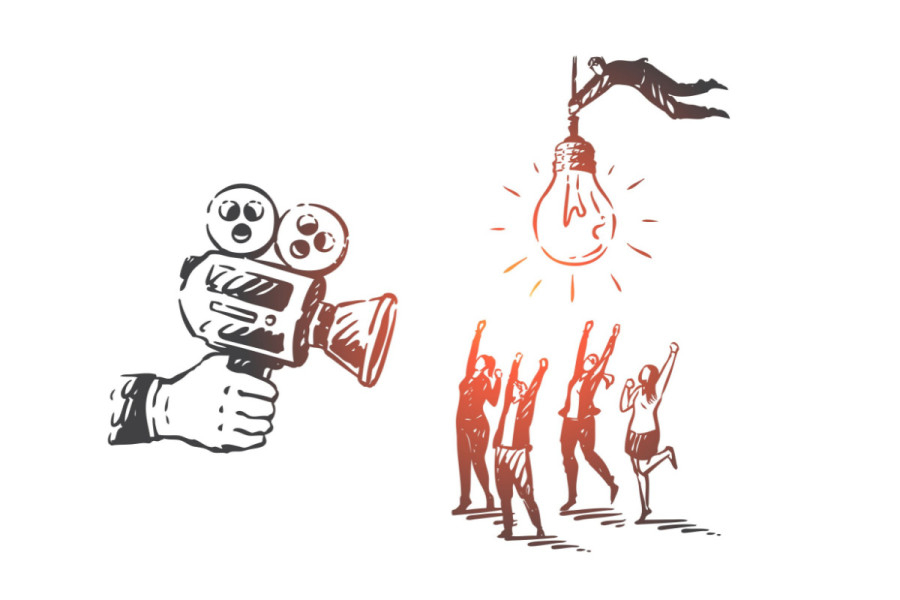Columns
Conflict of (attention) interest
Today, we have an increasing number of media persona types in relentless pursuit of attention.
Dharma Adhikari
Criticism of Nepal’s mainstream journalism has recently centred on the issue of conflict of interest—that news media owners utterly lack transparency in their dealings despite their persistent calls for professional integrity in other occupations or services. Oddly, but not surprisingly, a series of editorialising write-ups appeared in different news outlets, demanding transparency in the media. None tried to lay bare their own flaws or foibles.
I can’t help but agree that our media needs to do some serious soul-searching on its moral standing, but the bone substance of criticism seems almost always driven by some sensational headlines or pronouncements and hardly focuses on remedies. Hubris takes precedence over the issue. Over the years, suggestions on empirically driven assessments of the business networks of media owners, à la “who owns what,” or their extent of concentration, have largely fallen on deaf ears.
Anecdotes on how an owner-publisher combo derives unprofessional advantages from his relatively privileged position in society have made rounds since the days of the avowedly partisan weeklies. Today, cries of such conflicts have become louder and cacophonous, thanks to the regurgitating power of social media. And, increasingly, they are the influencers or media personas who present themselves as the standard bearers of media quality and credibility. Whether their own personal attention interest compromises their judgment is something we don’t ask as much or as effectively at a time when influencers dominate the attention economy.
In our context, we should perhaps talk more about conflict of connections than interests. The English word “interest” is deceptively dignified as an object of passion or a noble pursuit of individual gain. Increasingly, interests have been superseded by media-induced conflicts of attention or, rather, conflict for attention. The connections reveal themselves not only in the form of the traditional dai-bhai type of kinships that the sociologist Dor Bahadur Bista encapsulated in his “afno manchhe” construct but also, in recent times, in the ever-burgeoning web of parasocial relations or intimacies.
Parasocial lives
The media psychology of the audience appears enigmatic. Since the heydays of television in the 1950s, psychologists have noted that audiences develop a one-sided relationship with their favourite media personalities or performers on screen. Audiences even find themselves involved in an imaginary interpersonal interaction with the performers, whom they tend to idolise as personal friends. Over time, through repeated media use, viewers cultivate intimacy with the performer. In the social media age, such relationships are no longer always one-sided.
Today, we have an increasing number of media persona types in relentless pursuit of attention. Users, as well as personae, have the means—so far, largely abused or underutilised—to talk back to each other. With a single viral post, a user also may establish oneself as a persona in his or her own right, although the connection may turn out to be fleeting or less authentic than the one with the traditional media figures.
The real issue is that persona is about the image or the guise of the person rather than the person himself or herself. It is about media production techniques such as camera angles and close-up shots. It is about programming antics like the use of direct conversational style, rhetoric, and relatable verbal and nonverbal cues that create an illusion of intimacy with the audience. The target is anybody looking for social connections or validation of their own selves.
Another thing to note, especially in the web 2.0 “social” hype, is that the connections are parasocial, or near social, not social. In other words, we are in “a kinda world,” not the world itself. Resemblance, or the illusion of connections, is the way of life. We are almost there but never there. We are ever more removed from the context. Even the missing connections for reasons of poor production techniques or programming antics are to be respectfully accepted, not questioned, hence the oft-repeated refrain: milayera bujhdinus na! The burden of educating now lies on the learners.
The parasocial phenomena in the new media age feed on more attention and connections, requiring a semblance of collaboration with others. This incarnate experience reflects across our communicative lives, politics, economy, culture and everything. Milera jaane, going together, becomes the mantra. But nobody has to really join anyone to go anywhere.
Our intimacies in our highly networked, mediatised world are more fancied than real and often mutually corrupting. Such connections do not demand any ideological or moral standing. Leadership, as we know it, is dead. Follow the followers. Be a co-leader. Parasociablity today is about wanting mutual validation, not about rigid principles. It is about having no goal other than having a goal. Our functional loyalty is to the nebulous network effect itself. We have made a full circle, at least in terms of relapsing to our primordial communal instincts.
A fundamental shift has occurred in our way of life, not the least in villages across the country, in how we as individuals and as a society organise ourselves or make sense of ourselves. People go viral to go viral. Our networked selves, projected through our visceral intimacies with TikTok or ChatGPT, now transcend geographic boundaries for more attention. Connections are merely for an association, for a sense of self-validation; economic or political gains are not guaranteed, and the connections do not even harbour such outcomes. We have no goal other than to have a goal.
It is a different type of self-interest, which has given rise to not only conflict of attention but also conflict in and conflict for attention. Conflicts reveal in taking the image for the persona, noise for substance; in the time, energies or priorities lost; and in the anxiety, disappointments or possible breakups with the performer or co-performer. The societal implications of para-sociability go even deeper and wider.




 6.12°C Kathmandu
6.12°C Kathmandu















